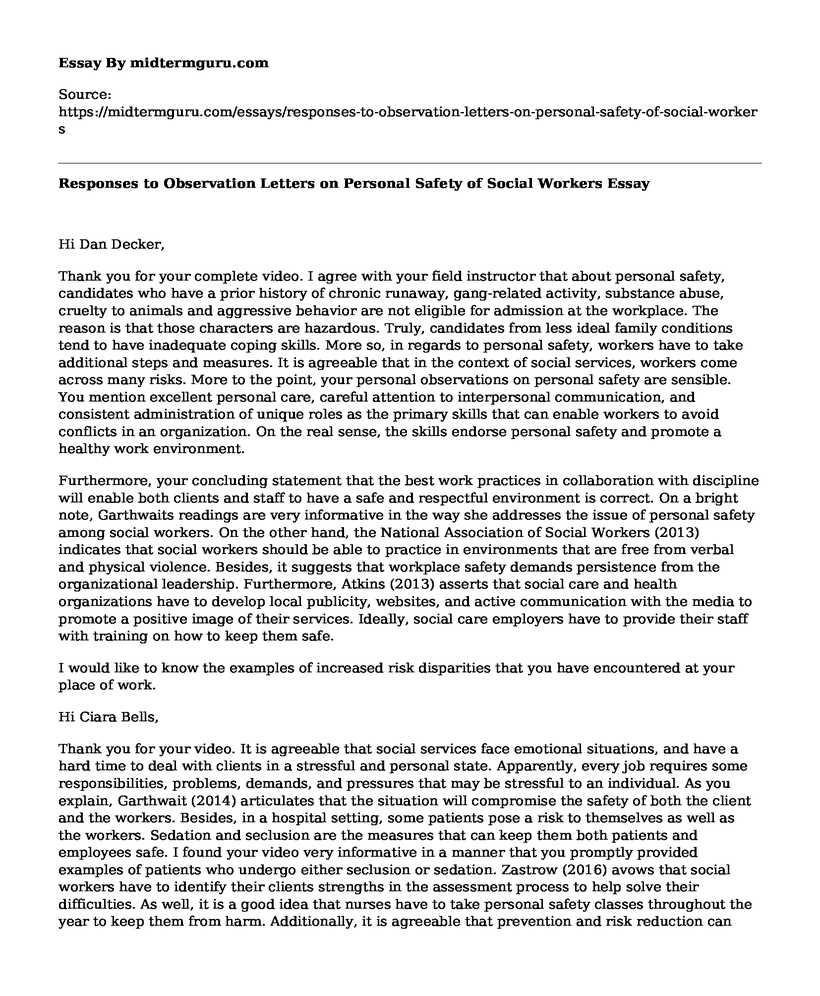Hi Dan Decker,
Thank you for your complete video. I agree with your field instructor that about personal safety, candidates who have a prior history of chronic runaway, gang-related activity, substance abuse, cruelty to animals and aggressive behavior are not eligible for admission at the workplace. The reason is that those characters are hazardous. Truly, candidates from less ideal family conditions tend to have inadequate coping skills. More so, in regards to personal safety, workers have to take additional steps and measures. It is agreeable that in the context of social services, workers come across many risks. More to the point, your personal observations on personal safety are sensible. You mention excellent personal care, careful attention to interpersonal communication, and consistent administration of unique roles as the primary skills that can enable workers to avoid conflicts in an organization. On the real sense, the skills endorse personal safety and promote a healthy work environment.
Furthermore, your concluding statement that the best work practices in collaboration with discipline will enable both clients and staff to have a safe and respectful environment is correct. On a bright note, Garthwaits readings are very informative in the way she addresses the issue of personal safety among social workers. On the other hand, the National Association of Social Workers (2013) indicates that social workers should be able to practice in environments that are free from verbal and physical violence. Besides, it suggests that workplace safety demands persistence from the organizational leadership. Furthermore, Atkins (2013) asserts that social care and health organizations have to develop local publicity, websites, and active communication with the media to promote a positive image of their services. Ideally, social care employers have to provide their staff with training on how to keep them safe.
I would like to know the examples of increased risk disparities that you have encountered at your place of work.
Hi Ciara Bells,
Thank you for your video. It is agreeable that social services face emotional situations, and have a hard time to deal with clients in a stressful and personal state. Apparently, every job requires some responsibilities, problems, demands, and pressures that may be stressful to an individual. As you explain, Garthwait (2014) articulates that the situation will compromise the safety of both the client and the workers. Besides, in a hospital setting, some patients pose a risk to themselves as well as the workers. Sedation and seclusion are the measures that can keep them both patients and employees safe. I found your video very informative in a manner that you promptly provided examples of patients who undergo either seclusion or sedation. Zastrow (2016) avows that social workers have to identify their clients strengths in the assessment process to help solve their difficulties. As well, it is a good idea that nurses have to take personal safety classes throughout the year to keep them from harm. Additionally, it is agreeable that prevention and risk reduction can occur when every staff within the hospital is aware of any potential hazard by the patients.
Most importantly, in a hospital setting, policies and practices have to be in line with the safety of both patients and the staff. As your video suggests, it is agreeable that the policies and practices will help to reduce some emotional encounters by the staff. According to Zastrow (2016), social workers need to identify the social policies that have an impact on the well-being, delivery of services, and access to social services at the local, state, and federal level. He suggests that social work students can work together against oppression in the workplace when they utilize the translation of research evidence to notify and expand practice, course of action, and provision of services. Overall, a social health worker has to be knowledgeable and competent in a range of responsibilities.
References
Atkins, B. (2013). Personal Safety for Social Workers and Health Professionals. Hertfordshire: Critical Publishing.
Garthwait, C. (2014). Social Work Practicum, The: A Guide and Workbook for Students, 6th Edition. Pearson.
National Association of Social Workers. (2013). Guidelines for Social Worker Safety in the Workplace. Retrieved from https://www.socialworkers.org/practice/naswstandards/safetystandards2013.pdf
Zastrow, C. (2016). Empowerment Series: Introduction to Social Work and Social Welfare: Empowering People. Boston: Cengage Learning.
Cite this page
Responses to Observation Letters on Personal Safety of Social Workers. (2021, May 27). Retrieved from https://midtermguru.com/essays/responses-to-observation-letters-on-personal-safety-of-social-workers
If you are the original author of this essay and no longer wish to have it published on the midtermguru.com website, please click below to request its removal:
- Essay Sample: Ethical and Legal Dilemma
- The Impacts of Media on the Individuals and the Society - Essay Sample
- Quality of Life in Early Childhood: A Must-Know - Essay Sample
- Leadership, Culture & Organizational Goals: A Crucial Relationship - Research Paper
- Exploring the Causes of Autism: A Closer Look at ASD Symptoms - Essay Sample
- Nutrition Assessment: Determining Nutrient Extent for Optimal Health - Essay Sample
- Leadership Defined: Science or Art? - Essay Sample







